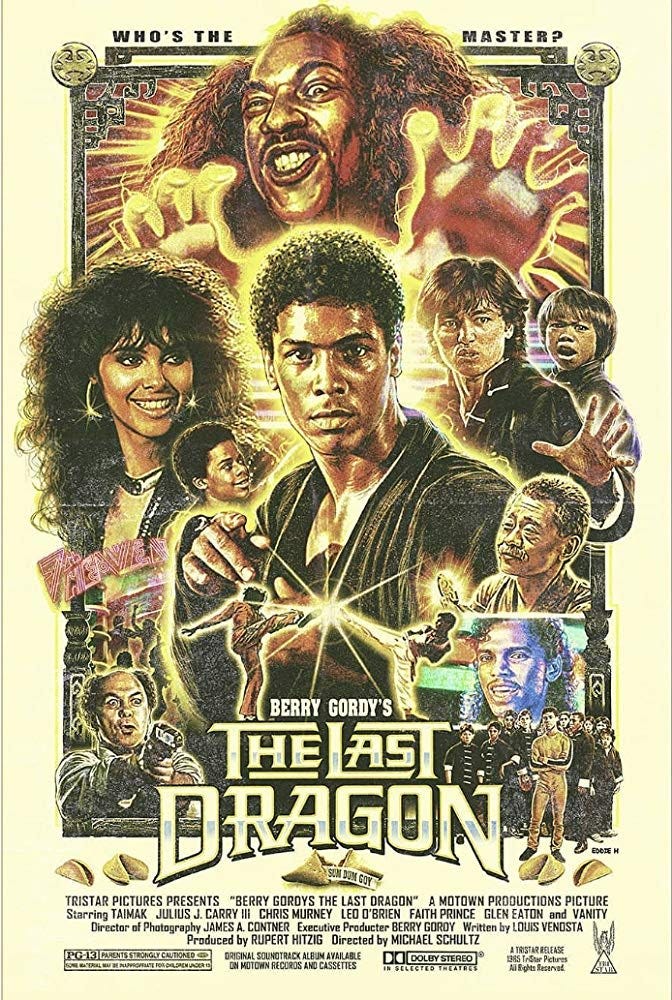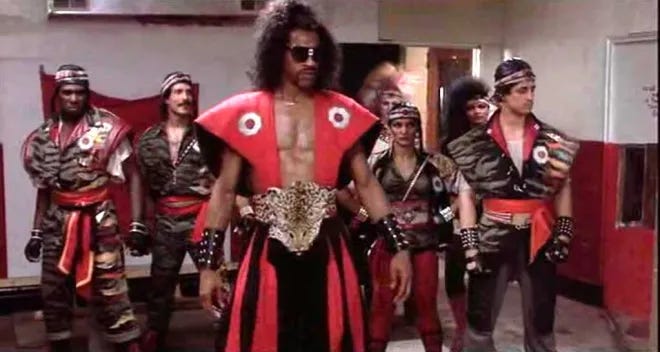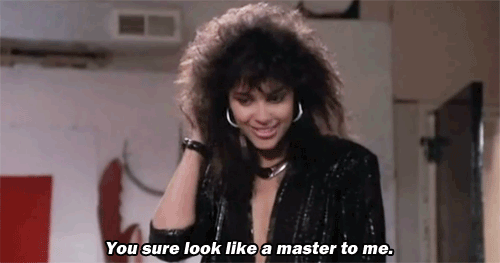Who's the Master? Luke Y. Thompson Reviews the New 4K of Berry Gordy's The Last Dragon
Sho 'Nuff
The main reason I wanted to review The Last Dragon on 4K is that it's possibly the last of the great '80s family classics I've never seen. Oh, depending on your definition of “classic,” there might be more – I've never seen Solarbabies, for example. The Last Dragon, however, seemed like a big omission, one I wanted to see at the time but (a) couldn't interest anyone else in and (b) probably wouldn't have had the right frame of reference for anyway. In 1985, I was in Ireland, and contrary to what The Commitments might make you think, Irish pre-teens of the mid-'80s knew nothing about Motown, or even black people, generally. The undeniable hugest music stars of color in the world, Michael Jackson and Prince, were dismissed for their flamboyance with homophobic slurs. Those who wanted to act ultra-manly favored AC/DC, while those not quite into metal liked Bruce Springsteen, Phil Collins, and any number of synth-pop bands that were likely far more gay than Prince and Michael Jackson in real life, but hiding in plain sight through music videos featuring hetero love-interest actors. Not one of my classmates could have told you who Berry Gordy was.
It might go without saying that I'd never seen a kung fu movie or a blaxploitation film at the age of 11, and it's unlikely my parents wanted me seeing one, my mother being a hardcore anti-violence feminist and my dad being an art snob. The Last Dragon is pretty kid-safe as action movies go, but its most obvious forerunners less so. Bruce Lee movies were not shown to Irish kids; I'm not even sure when I became aware of him, but it wasn't till my 20s that I saw Enter the Dragon.
Everybody, though, heard “Rhythm of the Night,” the DeBarge single pointedly billed as coming from The Last Dragon soundtrack. Because music reached our shores nearly instantaneously while movies took months, that gave us all a while to wonder what this Last Dragon movie could be that had that song in it. As I just found out watching the movie at last, “Rhythm of the Night” was actually the second top-ten hit for a then-unknown Diane Warren, which is kind of mind-blowing. Now a bona-fide movie-soundtrack hitmaker, she's also responsible for such absolute horrors as Michael Bolton's “How Am I Supposed to Live Without You.” I wouldn't have thought of her as a Motown sort of songwriter, but Berry Gordy knew talent.
I'm sure I was probably disappointed to realize there were no actual dragons in The Last Dragon. I remember asking a friend who had seen it if there was anything disgusting in it; he thought I meant violence, while I was thinking of sex. By that age I could handle some of both, but preferred to avoid the latter, even though I had been okay with Purple Rain. Regardless, I missed the movie entirely until now, as a film critic in my forties. Frankly, this is probably the best time for me to discover it. I can't tell you for sure how it would have played for me in 1985, but in 2023, the sheer eighties-ness of it hits me like a sugar high. All that hairspray! Parodies of early music videos! TV dance-to-the-hits shows! Early proto-rap! An implied piranha tank containing a monster fish we never actually see! And the movie's plot stopping completely dead so we can watch the DeBarge video. How about the fact that the two lead actors are simply named Taimak and Vanity?
There's a Star Trek meme in here somewhere. “Taimak and Vanity, when the limo stopped!”
By modern standards, the lead character of Leroy Green, a.k.a. “Bruce Leroy,” is right on the line of what folks now find problematic. Born into a normal, black Harlem family, he idolizes Bruce Lee so much that he dresses in Chinese clothes (including a large wicker hat) and speaks in the sort of slang-free, grammatically perfect English that a student speaking it as a second language might. To bring back Star Trek for a second, he talks like Data, and bows to his parents, calling them Mama-san and Papa-san. Though it's not my opinion that should be the final ruling on this topic, he avoids coming off as offense to my eyes simply because Taimak plays him so guileless and innocent. It wouldn't occur to him that there's any other way to be, or that he's hurting anyone's feelings. And it's part of an overall pattern in the movie, which also has Asian actors trying to act and dress like soul brothers, and one Asian-American who pretends to be a Chinese kung fu expert even though he's not.
The scene where he tries to go undercover, and talk like he perceives every other black person to, is one of the funniest, no doubt. As is a moment where his brother forces him to try and rap, though in 1985, that word didn't quite mean what it does now.
Having reached a high enough level of martial arts training that he can snatch arrows out of the air and break them, Leroy is looking for the next-level master, who he's been told is named Sum Dum Goy. (It's too bad he doesn't have any Jewish friends who could have clued him in on the joke a lot sooner.) Meanwhile, a psychopathic giant by the name of Sho Nuff (Julius Carry), who sports football shoulder pads and a massive samurai-afro, wants to fight Leroy simply because he's pissed off that anyone might suggest Leroy's better. This self-professed Shogun of Harlem doesn't seem to have a day job or anything; he just walks around with his posse of six similarly clad disciples starting fights. Even when offered money to beat up Leroy, he refuses it, apparently surviving on pure evil. Surely everyone agrees that Sho Nuff is a perfect name for such a character; writer Louis Venosta could have done no better.
For the other villain, the Kurt Fuller to Sho Nuff's Tiny Lister, we get Christopher Murney as Eddie Arkadian. Read that now and think, “Oh, he must be Armenian.” I don't think anybody thought that then – he's named “Arkadian” because he made his fortune in video games, which at the time were mostly played in arcades. His whole beef is that he wants his girlfriend's music video played on the locally filmed TV dance show hosted by glamorous, hairspray-loving Laura Charles (Vanity). She refuses, however, because the video is bad. Everybody warns her that it's not really a stand worth taking, since merely playing that one Cyndi Lauper knockoff might spare you the possibility of Eddie murdering people. Even young William H. Macy, as an assistant with just a few lines, gets to show off that adage about how there are no small parts as he admonishes Laura. But no, she has integrity. Her show, on which El DeBarge sings the “Coke is it” jingle at the top of the hour, would never sell out.
As a result, Eddie keeps trying to kidnap Laura, and Leroy keeps trying to save her. Sure enough, Sho Nuff's interests begin to align with Eddie's. There's a final fight featuring rotoscoped animation effects that feels like a predecessor to the Street Fighter games. That part, at least, I know I'd have liked as a kid.
And the movie is super-horny for him, too, mostly via Vanity's gaze but also the camera's.
It's all a kind of elevated grindhouse years before Quentin Tarantino started trying the same thing, borne of the audience that watched Bruce Lee movies in Times Square theaters in the '70s and early '80s. Unlike Tarantino's versions, or even Bruce Lee's films, it aims to bring in kids too, cognizant that young black action heroes were rarely seen onscreen, and might inspire the youngsters. Like many of the larger-than-life heroes of the '80s – think Optimus Prime or Hulk Hogan – Leroy may seem like a cornball goody-goody, but his also the baddest man on the block. And the movie is super-horny for him, too, mostly via Vanity's gaze but also the camera's. Vanity's talent for looking thirsty far eclipses any she allegedly has at singing, but the same was pretty much true of every female Prince protegee.
In addition to William H Macy, The Last Dragon features extremely early performances by The Cosby Show's Keisha Knight-Pulliam, always a natural, and Ernie Reyes Jr., whose fight skills impress even at his very young-looking thirteen years of age. Taimak mostly did TV after, and it seems a shame that he never did more, but while his performance is strong and a cut above those in many action movies of the same era, it's a result of round-the-clock acting coaching. Clearly, it worked – it's fair to say Taimak has more range here than a Stallone or Schwarzenegger typically did, but after watching the extras, one gets the impression that blood may have been drawn from a stone, so to speak, to get there.
This was the last of four films Gordy produced or directed while at Motown, prior to selling his stake in the company. The other three were Lady Sings the Blues, Mahogany, and The Bingo Long Traveling All-Stars and Motor Kings, all of which are well-liked to this day, and helped make a star of Billy Dee Williams. It's a hell of a track record for such a short run, and one is left to ponder what more he could have done had movie-making remained a passion.
The 2015 Blu-ray, included in the new 4K steelbook, features a commentary by director Michael Schultz (Car Wash, Cooley High), who alludes to some disagreement with Gordy about the tone of the movie. Perhaps that dissuaded the producer from more, but Gordy's movies were always a mix of genres. Schultz wanted to push the cartoonish designs even further, but acknowledges that the moments which feel real help balance out the more absurd aspects. It's a commentary full of insight on exactly how the movie was made, and worth the listen; it pairs well with the sole featurette, which is a making-of/retrospective featuring Gordy, Taimak, Schultz and more.
For the 4K, a new fan commentary has been added featuring comedian Amber Ruffin and her sister/sometime co-author Lacey Luffin. They clearly geek out about this movie, calling it the greatest ever, and mostly point out the things they enjoy and why they enjoy them, all while ribbing each other. It doesn't offer many new insights, but it feels like watching with friends and having fun unironically loving the ridiculousness. As far as the movie itself, scanned from camera negative with the director's supervision, it tones down some of the brighter excesses of previous transfers, feeling more like the real New York of the '80s, and showing every bead of sweat on Taimak's perfectly toned bod. Grain is finer than before, and everything is super-clear.
I'm not necessarily ready to call The Last Dragon a classic, but it's one of those movies that was so in tune with its times that it works almost better as a period-specific piece. In a just world it would have started a franchise – again, if Taimak's acting coaches, one of whom was Gordy himself, had the patience. The soundtrack, “Rhythm of the Night” aside, is a real mixed bag to my ears, often awkwardly pairing retro-soul vocals with new-wave synth in non-complementary ways. Ironically, the songs by Faith Prince that are “meant” to be bad are among the best. If your kids are old enough to begin to understand kung fu and blaxploitation, and have an interest in those ancient relics we once called music videos, it feels like a decent place to start.
One question for the group reading this: am I the only one who, until very recently, thought the lyric was, “Gonna be to the rhythm of the night”? Yes, now I know it's “Feel the beat of the rhythm of the night.” And that makes more sense. But, y'know, song lyrics didn't always make sense offhand. I always loved Prince, but what even is “Till I find the righteous 1, computer blue”?









It's stuff like this that make me wish Motown had stayed in Detroit and Berry Gordy wasn't so damned ambitious.